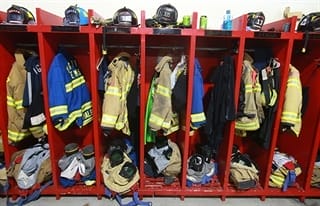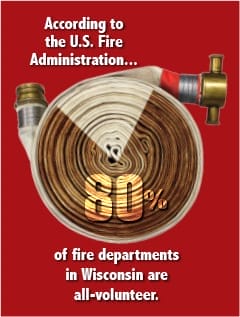A decade ago, the Grafton Fire Department was a private, all-volunteer service that had operated the same way for more than a century.
By 2012, however, that model wasn’t keeping up with the needs of the community and the department appealed to the Village of Grafton for help. That year, the department became part of the municipality and its structure changed to accommodate a paid chief and paid on-call firefighters.
It took a referendum to make it happen, and once Chief William Rice was employed, he swiftly realized the department also needed a paid fire inspector.
Now, that’s how the roughly 70-member department works: a paid chief and fire inspector, firefighters who earn $10 to $15 an hour for time spent at a fire scene and a roster of emergency medical service providers who are paid to be in the station awaiting calls during the day and on call on nights and weekends.
The department plans to add full-time firefighters/EMS, with the first such position being funded in July.
Rice, who is constantly trying to find new volunteers and juggle the needs of the community and his department, sees major changes ahead for departments like his.
“There’s no way our department or many of my neighboring departments will be able to go on like this,” Rice says. “I’m assuming there will be some kind of regional approach in Ozaukee County. Whether that’ll be a few communities that will get together, the entire county, whether it’ll reach beyond the county borders, I don’t know.”
Most departments are volunteer
The U.S. Fire Administration, part of the Federal Emergency Management Agency, registers fire departments nationwide to conduct studies and keep statistics. It estimates that 91 percent of the departments in the country are registered, and according to its numbers, 80 percent of fire departments in Wisconsin are all-volunteer. That’s about 617 of the state’s 767 registered departments.
There are about 92 mostly-volunteer departments, or 12 percent, and 5.6 percent of the state’s departments are career, or all-paid.
Nationally, about 70 percent of firefighters are volunteer, according to the National Volunteer Fire Council, and one critic of traditional fire department practices suggested the volunteer model become the standard.
University of Miami law and economics professor Fred S. McChesney, in a 2015 Washington Post op-ed, offered a drastic remedy to cash-crunched cities: Scrap full-time firefighters and convert to all-volunteer departments.
Big cities and taxpayers are saddled with unionized firefighters and their accompanying high salaries that are “incompatible with their declining firefighting needs,” wrote McChesney, who died last fall.
However, according to Grafton’s chief, the clock is ticking on the all-volunteer or mostly-volunteer models.
One big problem is finding people willing to make a commitment, especially on nights and weekends when family obligations and personal interests compete. For Rice, nice weather and the lure of recreational activities can be a challenge.
“Here in Grafton, it’s kayaking on the Milwaukee River,” Rice says. “I can lose 10 to 12 volunteers for half a day with that one suggestion. Fire departments around the country, our state, neighboring counties — we all deal with these issues.”
Rice says he strives for a minimum of 15 firefighters at an active fire, and he relies on mutual aid agreements with neighboring departments to make it happen. That’s also partly why he’s working to grow the paid component of his department.
“We’re a small county — we have a handful of communities that are between 15,000 and 25,000 people, and we’re being pressed pretty hard,” Rice says. “We’re probably ahead of it. By end of the year, we’ll have three full-time firefighters, more than any other department in our county.”
Rice sees a national transition toward full-time fire personnel, but it’s a slow transformation because most communities are driven by “tragedy planning.”
“Communities will wait until there’s some kind of tragedy and plan for it not to happen again,” he says. “There are people saying, ‘There are so few fires. Why do you need all these people, all these engines and equipment?’ I think there are economies to be looked at there. Even though we don’t have a lot of fires, you need a lot of people to fight fires. For anyone to say to a fire chief that he should go to a fire with fewer people is to say, ‘We don’t value the humans you have working on your department.’ ”
In Racine County, Tom Czerniak, longtime chief of the all-volunteer Union Grove-Town of Yorkville Fire Department, says the emphasis on medical runs compared to firefighting has not caused problems in his department. In 2016, his department had 602 EMS calls and only 118 fire calls.
His is the only volunteer department in Wisconsin deploying paramedics as well as EMTs on emergency calls, Czerniak says. He has 33 volunteers, about half of whom work as full-time firefighters or EMTs in other communities.
In Sheboygan County, the Town of Sheboygan Volunteer Fire Department has about 35 members who are paid an $800 annual stipend. With the town’s EMS service, the number grows to about 48, and there is a little overlap between the two, says Chief Roger Benzschawel.
The department’s $128,000 budget comes from the township. On top of that, however, the department runs a fundraiser that brings in $20,000 to $23,000 each year.
Though Benzschawel says he has never been shorthanded at a fire scene, it might only be a matter of time. “As a fire chief, when you turn around, you want to see your resources. When you turn around and you don’t see that, something’s gone wrong. … We’ve been fortunate enough to have enough people show up.”
To keep it that way, Benzschawel is planning ahead. “The first step is to look at hiring a full-time chief and a full-time EMS coordinator to start taking care of operations here.”
All-volunteer or mostly-volunteer departments aren’t sustainable, Benzschawel says.
“I think you might see some fire departments having to pay their firefighters more,” he says. “You might see more fire departments around this area go to the wayside. Fire department territories will get bigger. I think that’ll end up being the wave of the future.”
Janet Weyandt of Sheboygan is a freelance writer. Dave Daley of the Badger Institute contributed to this story.
Related stories:
► Time to burn: So few fires to fight
► Government grows at expense of private sector
► Clinging to an old picture








